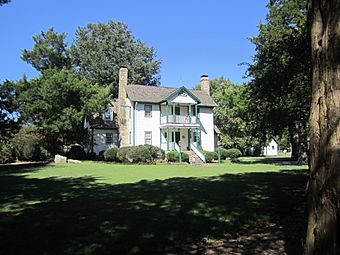Bennett Bunn Plantation facts for kids
Quick facts for kids |
|
|
Bennett Bunn Plantation
|
|
 |
|
| Location | NC 97, near Zebulon, North Carolina |
|---|---|
| Area | 181.5 acres (73.5 ha) |
| Built | 1833 |
| Architectural style | Federal |
| NRHP reference No. | 86000157 |
| Added to NRHP | February 4, 1986 |
The Bennett Bunn Plantation is a historic farm located near Zebulon, a town close to Raleigh. This old plantation, found in eastern Wake County, has a large two-story house built in 1833. It also includes barns and about 162 acres of farmland and forests.
The Bunn family owned this property for many generations. In 2000, Grace Hutchins, a great-granddaughter of Bennet Bunn, sold the land. Today, the house is still a private home. It was added to the National Register of Historic Places in February 1986, recognizing its important history.
Contents
The Bunn Family's Story
Bennet Bunn received this land from his father in the 1820s. He first lived in a simple log cabin on the property. After saving enough money, he built the main house in 1833.
To run the farm, Bennet Bunn used the forced labor of 16 enslaved people. They helped him grow crops like wheat and corn, and also raised animals. For many years, the property was passed down through the Bunn family, often going to the youngest daughter.
Grace Hutchins, who inherited the property later, made some modern updates to the house. She added electricity and plumbing, and also built a kitchen, a sunroom, and new bathrooms.
A Look at the House's Design
The Bennett Bunn house is a great example of Federal architecture. This style was very popular for homes in the southern United States before the Civil War.
When you drive up to the house, you'll see a long driveway lined with tall cedar trees. These trees were planted in the 1920s by Alac and Avon Bunn, adding to the plantation's historic look.
Stories from the Civil War
During the Civil War, a robber once threw a burning torch through a front window of the house. The mark where the torch hit the floor can still be seen today!
There's also a special mantel clock displayed in the house. A soldier from the Union gave it to the Bunn family. He had taken the clock from another place but got tired of carrying it around.
Remembering Enslaved People
On one of the walls inside the house, there is a memorial. It remembers two enslaved people, Simon Bunn and Joni Piedelle, who died in the 1860s.
There is also a small cemetery on the property. Five enslaved people who worked at the Bunn plantation are buried there. This cemetery helps us remember their lives and contributions.



